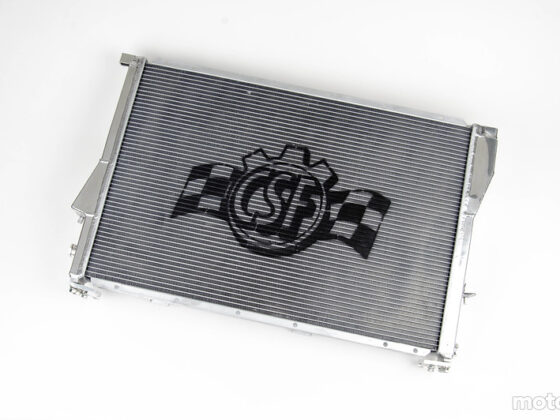
Wrong! At 50.38% front weight it only made a 0.45% difference in weight distribution! Moving the battery makes a bigger difference.

Next, we moved the engine 6.5″ forward. This is about where it was in FD legal configuration. You would think this would be a huge difference.

Nope, We now only have a 50.81% front-weight bias! Setting the engine back 6.5″ took quite a bit of expense and fabrication to only improve the weight distribution by 0.88%. You might even do a little bit better with battery relocation!

So now we wanted to see what effect just adding some weight might do. We pushed the engine back to its original position and plopped the 38 lb turbo right here. In real life, it is actually back a few more inches but we just wanted to see.

So this made the car have 50.78% weight on the front wheels. This is a 0.75 percent difference just from the weight of the turbo. So putting the turbo in position made about the same difference as moving the engine 6.5″!




11 comments
Thank You!
Huh… yeah, OK. Thinking, it’s a big chunk of mass but in the grand scheme of things moving it 6.5 inches is going to have much less effect than moving something that’s maybe a tenth the weight 6.5 feet (numbers out of thin air). But obviously does get to a point where the answer is “do everything you’re allowed to”.
Just musing; do you have general thoughts on when weight bias effects overwhelm mass centralization or vice versa? For example, and pretending you can get crossweight even either way, when would you prefer to put a hundred pounds of ballast in the passenger seat area vs the trunk?
Think of it more like using a breaker bar to break a really tight lug nut, as opposed to using a stubby wrench to break the same lug nut. With the battery being at the very front or very rear of the car, it could have the same effect as the much heavier engine toward the center of the car.
Just a thought.
“moving it 6.5 inches is going to have much less effect than moving something that’s maybe a tenth the weight 6.5 feet”
yeah i think that’s what he was saying
Right. My question was when fighting for more rear weight or fighting for better moment gets more critical to actual lap times… or at least a viewpoint?
I hear you… But as a thought process… We now know it doesn’t move much weight back…. But how would the car’s handling have changed…. Because the front end became lighter and if the motor was already behind the front suspension and moved the 6.5 inches back further…. I’m much more interested in the handling changes felt while autocrossing or road racing and even drag racing…. In a back to back comparison… Because you’re still shifting the polar moment and mass of the car backwards…..
As a second point….. how about moving the driver position back 8 inches and extending the steering and moving the pedal box…. Affects on the handling /performance…..
So you would want us to weld and cut the car a few times? Too tall of a request.
On my semi-scca prepared 68 Triumph GT6, at 2000 lbs, moving the battery from front to rear made a 5 point difference in weight distribution. In autocross wins, I added the rear spare fully to the rear to further improve weight distribution. Later for Summit Point raceway track days, the rear spare was replaced with a 9/16″ rear swaybar I designed using Fred Puhn’s great suspension book, to detrmine roll stiffness balance.
The GT6 OEM battery location:
https://www.alamy.com/triumph-gt6-mk-3-classic-car-engine-bay-at-the-oakamoor-hill-climb-13th-july-2019-oakamoor-staffordshire-uk-image260231847.html
One important thing to consider when thinking about weight distribution is rotational inertia. While drift cars mostly rotate around the front axle, so moving an engine doesn’t cause a huge difference, in regular racing or street driving while making a hairpin car will have a massive amount of rotational inertia because the engine moved forward and the rotation axle is somewhere near the center of the car. M(R^2) – formula for the moment of inertia and also the name of the car designed around its mitigation.
Simplified and not totally correct example.
Let’s assume our car has a wheelbase of 2.76m, let’s assume that our’s suspension rotation center is in the middle. Let’s assume our engine’s length is 0.65m and mass is M. If we put the engine inside the wheelbase inertia’s arm (distance between the rotational center of the car and the center of mass of the engine) would be 0.73m, so the moment would be 0.54M.
If we put half of the engine outside: the arm would be 1.055m and the moment would be 1.11M – more than two times increase of resistance.
I tracked a Porsche 924Turbo at Summit Point Raceway, and with the rear transaxle, the car had a high mass moment of inertia. It was easy to handle on 60+mph corners, as with slight rear roll resistance bias, the back end would come out in slow motion. I was following an insrtuctor’s 944 and his did exactly the same thing.
When setting up my light steel flweel on my 93 RX7-TT, to compare polar moments of inertia wit the stock flyweel, I suspended each in a horizontal plane with 3 strings of a specific length, and timed the periods of oscilation to do the calculations. Also measured the presssure plate this was. Net was a ~ 30% reduction in inertia, for quicker 1st gear acceleration … easier to spin the wheels on take off.